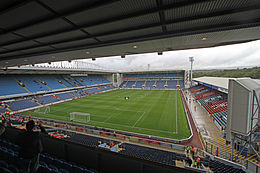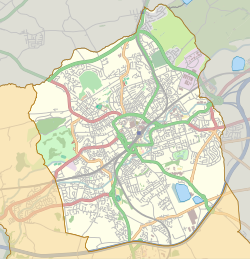Ewood
 |
|
|
Location in Blackburn
|
|
| Location | Blackburn, Lancashire, England, BB2 4JF |
|---|---|
| Coordinates | 53°43′43″N 2°29′21″W / 53.72861°N 2.48917°WCoordinates: 53°43′43″N 2°29′21″W / 53.72861°N 2.48917°W |
| Capacity | 31,367 |
| Field size | 115 yd × 76 yd (105 m × 69 m) |
| Construction | |
| Built | 1882 |
| Opened | 1882 |
| Tenants | |
| Blackburn Rovers F.C. (1881, 1890–present) | |
Ewood Park is a football stadium in the English town of Blackburn, Lancashire, and is the home of Blackburn Rovers Football Club — one of the founder members of the Football League and Premier League. Rovers have played there since they moved from Leamington Street in the summer of 1890. The stadium opened in 1882 and is an all seater multi-sports facility with a capacity of 31,367. It comprises four sections: The Bryan Douglas Darwen End, Riverside Stand (named as such because it stands practically on the banks of the River Darwen), Ronnie Clayton Blackburn End, and Jack Walker Stand, which is named after Blackburn industrialist and club supporter, Jack Walker. The football pitch within the stadium measures 115 by 76 yards (105 m × 69 m).
Football had been played on the site since at least 1881; Rovers played four matches there when it was known as Ewood Bridge and was most likely little more than a field. Their first match was against Sheffield Wednesday on 9 April 1881.
Ewood Park was officially opened in April 1882 and during the 1880s staged football, athletics and some form of greyhound racing (not oval). Rovers moved back in in 1890, signing a ten-year lease at an initial annual rent of £60. Their first match at the ground was against Accrington in September. In 1893, Blackburn Rovers bought the freehold of the ground for £2500, but came close to disaster soon after when part of a stand collapsed under the weight of a 20,000 strong crowd for the visit of Everton.
In 1903, a roof was built on the Darwen End of the ground, at a cost of £1680. The stand now held 12,000 spectators.
In 1904, the Nuttall Street Stand was built, based on designs by the architect, Archibald Leitch at a cost of £24,000. The stand was first used by supporters on New Year's Day 1907 for a match against Preston North End.In 1905, the textile baron Laurence Cotton became chairman and set about overhauling both team and ground. In 1906, construction started on a new main stand seating 4,112 on its upper tier with a paddock for 9,320 in front with changing rooms and offices underneath, cranked at one end to follow the angle of Nuttall Street.
...
Wikipedia

